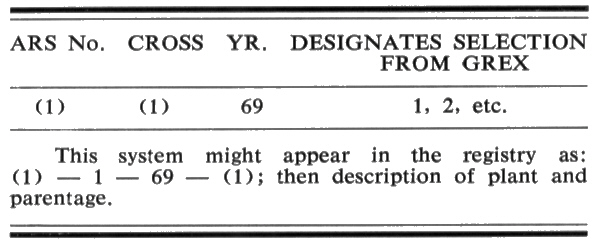Notes from an Amateur Rhododendron Buff
Art Childers, Vida, Oregon
I have spent 23 years growing rhododendrons as a hobby, the last 18 of which have been involved in hybridizing. At the present time some 20,000 or more hybrid seedlings are growing on from one to 18 years old. Until 1970, I had named only two plants, although others are of a quality worth naming and registering. Of the two named, one should not have been named, as it is of no commercial value but has proven to be an excellent parent. This plant should have been registered under a number only.
During the past 10 years, the number of names that have been registered is staggering. In another 10 years 95 out of every 100 of the plants will be a name only in the International Registry - names that cannot be used again.
The growing concern among conscientious and knowledgeable hybridizers to the indiscriminate naming of every pet plant that is brought into bloom, has prompted me to compile a formula of simple composition that would alleviate the bookkeeping of both grower and Registrar. I am setting forth some suggestions here that might be used, or if not used, that might bring forth better ideas from someone else.
I suggest that the society create a "Plant Register," preferably a loose-leaf one, for U. S. plant breeders only. The society would give each hybridizer a symbol, such as a number or letter, or both. The less the better. The registered symbol or letter would be used in conjunction with the hybridizer's personal symbols or code numbers. This information, along with a complete description of the plant and parentage as now used in the International Registry would be on file with the Society. It would allow the hybridizer to use the plant for breeding or to sell commercially, and if after 3-5 years it has proven commercially sound and has been rated by competent judges, it would be given a name of the owner's choice and registered in the International Registry. The file could then be up-dated to include the name.
With this procedure, the best seedling would be viewed by a panel of competent judges and would have to be awarded a rating corresponding to the P. A. before being given a name. If a sister seedling proved to be a better parent, which so often happens, it could be registered under number and be used for that purpose.
Also a simple form of patent sanctioned by the A.R.S. that would protect the hybridizer from mass production and cut rate sales for the first few years of production is needed, since this is the only time a hybridizer can reap any profits from his years of work and study. The plant could be judged by an ARS team, then tagged with an official seal which could be paid for by the grower. This would be registered under the plant's number or name and anyone propagating the plant for a certain period of time without the owner's consent would be liable to the owner.
A sample registration is listed below. I will use my own symbols in this case. Let's assume I received the first registered symbol which could be ARS 1, or A1, or A, or just 1. Then by combining it with my symbols and adding the number at the end in parenthesis it could always be checked back with my personal record and identified as being first, second, etc., of a certain grex. For a continuing pedigree, all plants to be used as parents should have at least a registration number.
